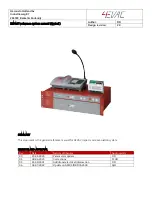
Principles of Grain Drying
35
P
RINCIPLES OF
G
RAIN
D
RYING
Note:
Information that follows includes general guidelines. Seek more specific information from your local
extension office or contact Midwest Plan Service, 122 Davidson Hall, Iowa State University, Ames, Iowa 50011.
I.
Basic Principles
● Air removes water from grain.
● The more airflow through grain, the faster drying occurs.
● The warmer the airflow through grain, the more water can be removed and the faster drying occurs.
● For every 20ºF (11°C) increase in drying temperature, relative humidity (RH) is cut by about half.
● The warmer the air, the drier the grain.
The table below illustrates these principles:
Table 10
- Effect of Heating on Grain
Outside Air
Air Temp
Heated to
Relative
Humidity
Dries Grain to
Drying Ratio
70ºF (21ºC),
60% RH
No heating
60%
13%
1.0
90ºF (32°C)
31%
8%
2.6
110ºF (43°C)
17%
5%
4.3
As table above shows, simply increasing air temperatures by 20ºF (11°C) - from 70ºF (21°C) to 90ºF (32°C) - cuts
relative humidity by half and generates a drying speed 2.6 times faster than original rate. Raising drying
temperature by 40ºF (22°C) - from 70ºF (21°C) to 110ºF (43°C) - results in drying times 4.3 times faster than were
no heat added. However, drying grain to 8% or 5% moisture content is very costly and also results in excessive
grain damage as bottom layers of grain are over-dried. By incorporating a stirring machine to mix dry grain at
bottom of bin with wet, upper grain, desirable average moisture may be obtained. University tests have found that
a properly stirred bin will have less than 1% variation in moisture content from top to bottom.
Dry air carries moisture away from grain, and higher airflow rates - determined by fan speed, motor size, and
grain resistance - create higher drying rates. Higher airflow rates through deep grain depths, however, cause
higher static pressure against fan, which decreases fan output. Short, wide bins allow grain to dry more efficiently
than tall, thin bins as they generate less static pressure and grain restriction within same amount of grain. As a
result, tall, thin bins may require 30 times more horsepower than short-wide bins to maintain same airflow, as
shown in
Figure 45
- Requirements for Drying in Different-Sized Bins
Summary of Contents for Fastir
Page 4: ...Limited Warranty 4 LIMITED WARRANTY...
Page 50: ...Appendix A Wiring Diagrams 50 Figure 52 Double Auger Fastir Wiring Diagram...
Page 51: ...Appendix A Wiring Diagrams 51 Figure 53 Triple Auger Fastir Wiring Diagram...
Page 52: ...Appendix A Wiring Diagrams 52 Figure 54 Quadruple Auger Fastir Wiring Diagram...
















































